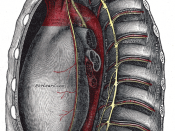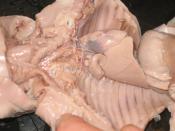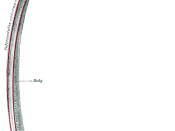Pulmonary Ventilation or breathing has two phases. Inspiration or inhalation moves air into the lungs, and expiration or exhalation moves are out of the lungs. The lungs are enclosed within the thoracic cavity. Thus changes in the shape and size of the thoracic cavity result in changes in the air pressure within that cavity & in the lungs. This difference in air pressure causes the movement of air into and out of the lungs. Air moves from an area where pressure is high to an area where pressure is lower. Respiratory muscles are responsible for the changes in the shape of the thoracic cavity that causes the air movements involved in breathing.
Inspiration occurs when the chest cavity enlarges. As the thorax enlarges, the lungs expand along with it, and the air rushes into them and down into the alveoli. Muscles of respiration that are classified as inspiratory muscles include the diaphragm it is the dome-shaped muscle seperating the abdominal cavity from the thoracic cavity. The diaphragm flattens out when it contracts during inspiration. The diaphragm is the most important muscle of inspiration. Nerve impulses passing through the phrenic nerve stimulate the diaphragm to contract. The external intercostal muscles are located between the ribs. When they contract, they enlarge the thorax by increasing the size of the cavity from front to back and from side to side. Contraction of the inspiratory muscles increases the volume of the thoracic cavity and reduces the air pressure within it, drawing air in the lungs.
Quiet expiration is ordinarly a passive process that begins when the inspiratory muscles relax. The thoracic cavity then returns to its smaller size. The elastic nature of lung tissue also causes these organs to recoil and decrease in size as air leaves the alveoli and flows outward...



Pulmonary ventilation
good concise overview. Good luck with your studies, from the uk.
0 out of 0 people found this comment useful.